Everyone Has a Will to Win, but Very Few Have the Will to Prepare to Win
— Vince Lombardi.
I was doing some research on my income investments while watching Monday Night Football (great game for Vikings fans!) when I came across a recent Insight post from Nuveen Investments. The title of the post is “Stay in the Game: Investing in a late cycle world.” The basic gist of the update, written September 28, 2023, by Nuveen Chief Investment Officer Saira Malik, is that many risk-averse investors are holding onto large amounts of cash, waiting to re-enter the investing game.
Today, many investors remain wary of inflation, monetary policy and a possible recession. But while these concerns continue, an important variable has changed: The economic cycle is further along, with the game clock running down. We think a winning investment strategy in this environment calls for getting off the sidelines and positioning portfolios for attractive late-cycle opportunities while they’re still in play.
In my recent article, “Asset Allocation: Shifting From Equities To Credit, Cash, And Gold,” I suggested that a reasonable holding in cash right now is not a bad idea when those cash assets can earn 5%+ in safe, short-duration holdings like Treasury bond funds or bank savings accounts. But for long-term investors who seek reliable income in retirement, there are better choices available, and waiting on the sidelines for a recession to pass through the cycle is probably not wise. It is better to play the game and load up on credit holdings and/or defensive equity positions that offer strong returns in the form of dividends.
Investors who modestly extend the duration of their fixed income allocation have the potential to lock in attractive yields given what should be a less volatile interest rate environment for the next several quarters. Additionally, generating yield in three different categories — defensive (traditional), alternative (less correlated to economic factors) and credit (greater yield per unit of risk) — allows investors to diversify income sources to meet specific portfolio needs.
From Nuveen’s point of view, which echoes mine as an income-oriented long-term investor, this is a good time to extend duration of high yield fixed income as we approach the end of the rate hike cycle. It may take another 6 to 9 months before the Fed decides to cut interest rates, but the top in bond yields is typically reached long before the rate cuts occur. Toward that end, this is the recommendation from Nuveen regarding current fixed income allocations:
Our overall portfolio focus is on flexibility and diversification across credit sectors versus over- or under-allocating to any one area. Within that context, we favor investment grade bonds and see value in senior loans, which offer attractive spread levels compared to other credit sectors. We also see value across securitized credit and select emerging markets debt regions experiencing more advanced hiking cycles and solid economies. For high yield, we continue to favor the BB area of the market, but believe that the strong rally and corresponding spread tightening has made valuations look more fair.
You may be familiar with some of the closed-end funds, or CEFs, that Nuveen offers, and they offer several that meet the criteria outlined above. Some of the taxable funds that are currently offered are shown in this snippet from the Nuveen Product Guide for Q323. The Nuveen Global High Income Fund (NYSE:JGH) is the focus of this article, but there are several others that income investors may be interested in at this juncture in the economic cycle as well.
Nuveen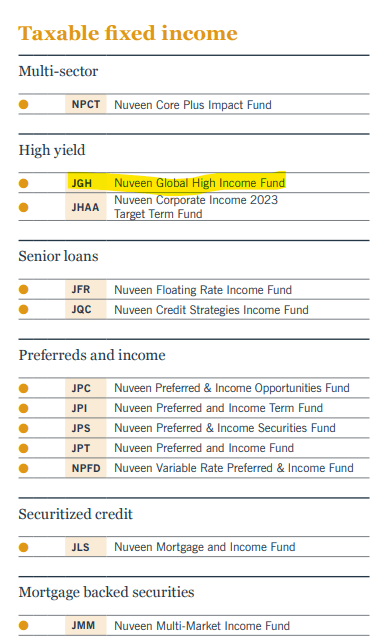
Back in July, Nuveen merged 4 floating rate senior loan funds into one, Nuveen Floating Rate Income fund (JFR). I had previously covered JRO, which was one of the 4 funds that got merged (along with NSL and JSD) into JFR back in March of this year, in “JRO: Not Too Late To Take Advantage Of Rising Rates.” I currently own shares of JFR and believe that the fund is still undervalued, trading at a discount of almost -15% while offering a yield of 13% with a distribution that was raised in August upon completion of the merger.
I also like Nuveen Credit Strategies Income Fund (JQC) right now, but do not currently own it because I already own 2 similar funds – XFLT and ARDC. This August, coverage from Nick Ackerman discussed JQC in adequate detail if you are interested in learning more about that fund. It also offers a yield of 13% and trades at a discount of about -15%.
While I have not investigated Nuveen Mortgage and Income Fund (JLS) in any detail, it also looks promising for income investors with a 10% yield, recently raised distribution, and also trades at a discount of -15%.
Lastly, before I dive into JGH, I recently learned that another fund merger is in the works for Nuveen. The Nuveen Preferred & Income Opportunities Fund (JPC) is about to merge with 2 other Preferred & Income funds. JPT and JPS will be merged into JPC. The merger is expected to be effective before the market opens on November 6. JPC also currently trades at a discount of -15%+.
JGH Overview
The fund description indicates that JGH seeks to deliver high current income through a diversified portfolio of global high-income securities.
Its managed assets will include at least 65% in securities rated below investment grade, at least 40% in securities issued by non-U.S. entities, and up to 25% in debt obligations from issuers located in emerging market countries. Up to 15% may be invested in unhedged non-U.S. dollar denominated bonds; derivatives may be used for hedging purposes only. The Fund uses leverage.
Like its sibling Nuveen funds, JGH currently trades at a wider than average discount of about -14% currently. The distribution history suggests a current distribution yield of about 12%. The dividend has remained unchanged for 2023 at $.1035 monthly.
The fund characteristics include a good diversity of holdings with an effective maturity exceeding 8 years.
Nuveen
The potential benefits of the fund’s investment strategy include a broad opportunity set from holdings around the world and across the credit spectrum, high income potential from global high yield bonds and other income-producing securities, and reduced interest rate risk due to global high yield bonds showing more sensitivity to corporate profitability than to interest rates.
The fund commentary as of June 30, 2023, discussed the portfolio composition and results through that date.
The Fund maintained overweights in energy, insurance, basic industries, cyclical service and retail. Sector and industry underweights included capital goods, communications, finance companies, real estate investment trusts (REITs) and consumer cyclicals. The team increased exposure to sectors like health care and communications that are in more essential service areas and had attractive valuations. Exposure was reduced in more cyclical issuers that could be more at risk if the consumer weakens. Key out-of-benchmark exposures remained including senior loans, preferred securities and contingent capital (COCO) securities. The team added around 3% to senior loans in the B rated range and approximately 1% to preferred securities. EM quasi-sovereign debt remained an underweight with an up-in-quality bias because of significant policy and fiscal issues affecting a broad array of sovereign issuers.
Top 10 Holdings include several high-quality names in finance, midstream energy, and global corporate entities.
Nuveen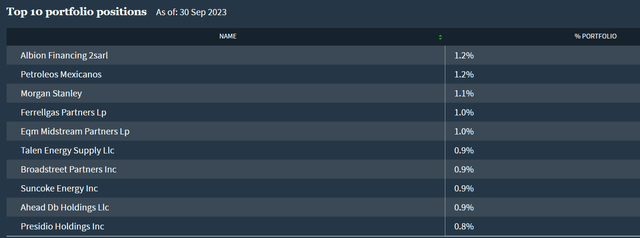
At the end of Q2, senior loans represented about 9% of portfolio holdings as did preferred securities. Credit quality for EM bonds was shifted into higher BB rated names post-Q2. The credit quality and call exposure as of June 30 is shown in this snippet from the fund fact sheet.
Nuveen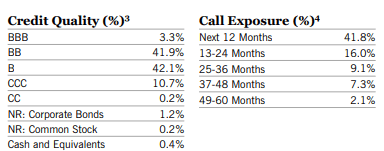
The portfolio allocation included 42% in US HY bonds, 21% in non-U.S. EM HY bonds, 15% in non-US Developed market HY bonds, 9% loans and 9% preferred/convertibles. Total managed assets as of June 30 amounted to $413M with effective leverage of 29%. As of September 30, the sector allocation changed slightly as shown on the fund website.
Nuveen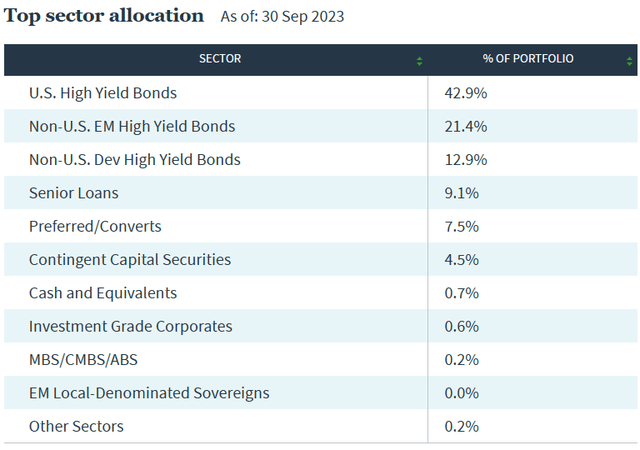
Fund Performance
Allocations to senior loans and preferred securities helped boost returns in the first half of 2023 while EM bonds detracted from it. Global high yield bonds finished the 2nd quarter with strong returns. The fund’s performance as of June 30 was quite good for the 1-year period from June 2022 to June 2023, but longer-term, since the fund’s inception in 2014, the average annual total return has not been much to write home about.
Nuveen
The JGH fund really struggled in 2022, which negatively impacted the long-term performance figures. This is even more apparent when reviewing the annual report for the period ending December 31, 2022.
Nuveen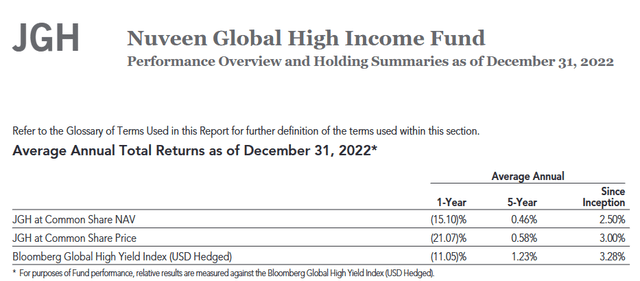
Looking at the YTD total return compared to JNK, the JGH fund was outperforming until the end of June but has lost a bit of ground since then.
Seeking Alpha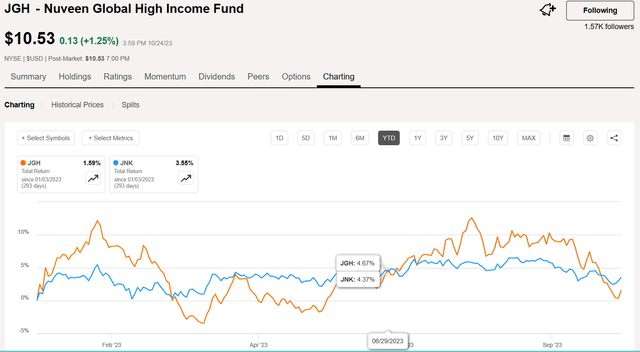
Part of that underperformance is due to a widening discount over the past two months. The current discount of -14% is the widest it has been since May, and nearly the lowest it has been in the past 52 weeks as shown in this chart from CEFconnect.
CEFconnect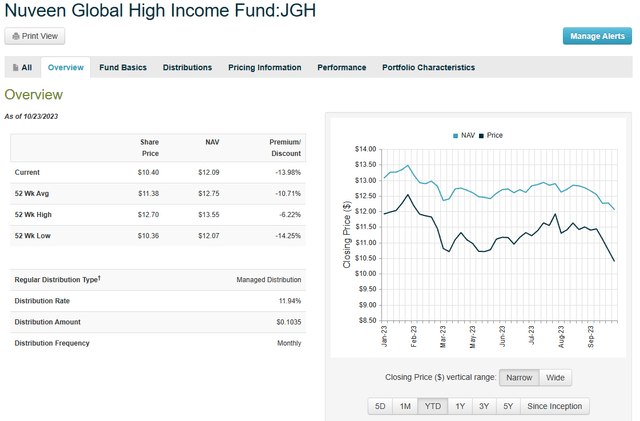
Distribution History
The fund uses a managed distribution that has seen some ups and downs (mostly down) over the past 10 years, as shown in the dividend history page from SA. Over the past several months about 75% of the fund distribution has come from NII and about 25% ROC. Earlier in the year, there was very little ROC so that could be a cause for concern regarding distribution coverage.
Seeking Alpha
The average earnings per share have not quite covered the distribution as shown in the table below from the fund website. The use of ROC* helps to support the high yield distribution when earnings coverage falls short.
* A return of capital is a non-taxable distribution of a portion of the fund’s capital. When a fund’s returns exceed distributions, return of capital may represent portfolio gains earned, but not realized as a taxable capital gain. In periods when a fund’s returns fall short of distributions, it will represent a portion of the investors’ original principal unless the shortfall is offset during other time periods over the life of the investment (previous or subsequent) when the fund’s total return exceeds distributions.
Nuveen
This may be one reason why the discount to NAV has widened over the past couple of months as investors fear a cut to the distribution.
Nuveen 19a
Summary and Recommendation
While the end of monetary tightening is not yet in sight (as some had predicted as recently as July), the end of rate increases could be coming soon and longer duration bonds is a good place to invest now given the expectation that global economies are slowing. At least according to Morningstar, the outlook for the 2nd half of 2023 and 2024 is looking optimistic for high yield bonds and corporate bonds in particular.
The combination of higher underlying interest rates and closer-to-average credit spreads is providing investors with some of the higher all-in yields we have seen in corporate bonds over the past 10 years. The Morningstar Corporate Bond Index currently yields 5.29% and the High Yield Index yields 8.03%. The main risk to our view is if the economy slips into a deeper and/or more prolonged recession, in which case default rates could rise.
Of course, if a deep recession occurs in 2024 then most asset classes will suffer, not the least of which is high yield bonds. But until then, and given the widening discount to NAV in the JGH fund, I believe that now would be a good time to add some global high yield exposure to your income portfolio if you do not already have some.
Yes, there is a chance that they will reduce the distribution in January (I hesitate to use the word “cut” because it sounds so drastic). While the fund is not currently earning its distribution, the likelihood that will change in the next 2 months is weak. Therefore, I believe that the fund managers will be most likely forced to reduce the distribution to a more manageable yield of about 8% of NAV starting in January.
In the meantime, the discount has widened to the point where I believe that the Nuveen Global High Income Fund is a Buy if you are looking to diversify into more global markets with high-yield income. If you already have a position in JGH or a similar high-yield global bond fund, I would not recommend adding here and would rate the fund a Hold. My suggestion would be to watch what happens over the next 2 months and see if the NAV begins to increase again, which could enable the fund to maintain its current distribution yield.
Compared to other global high yield bond funds such as ISD and GHY, JGH is showing comparable YTD total returns and may be in a good position to advance as the global economy recovers in 2024, unless it doesn’t.
Seeking Alpha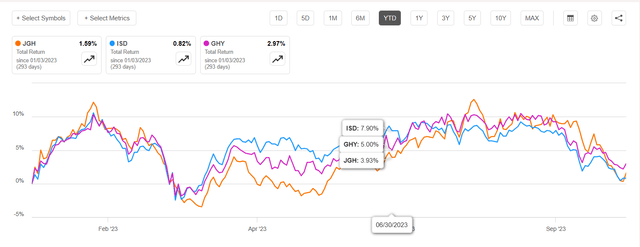
You can’t win if you don’t play the game so you might as well start now and see what happens. Good luck whatever you decide!
Read the full article here



